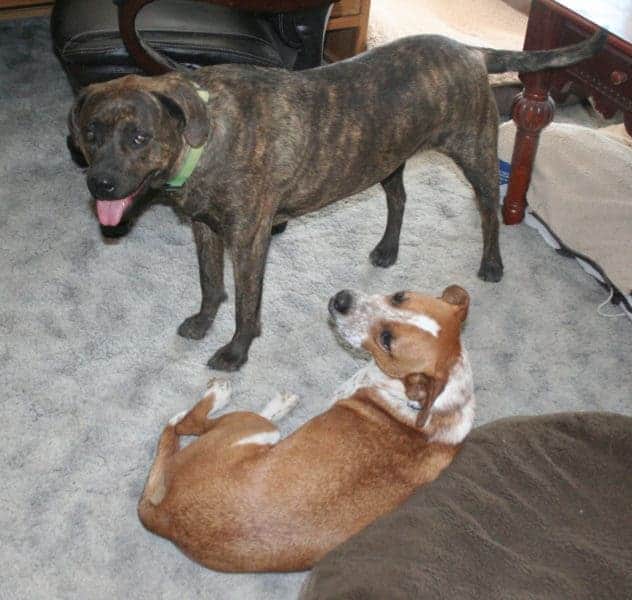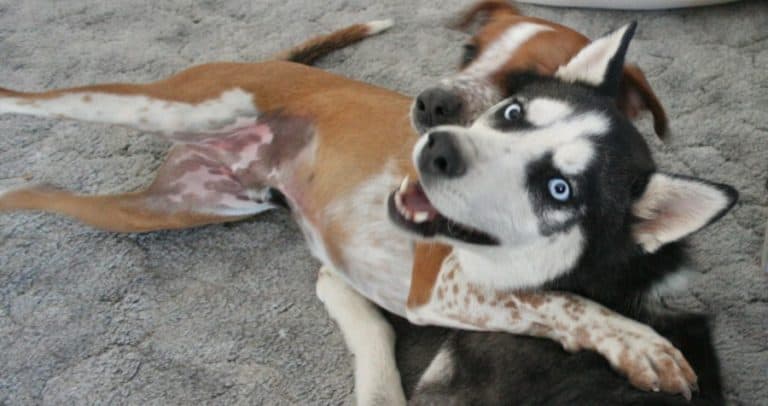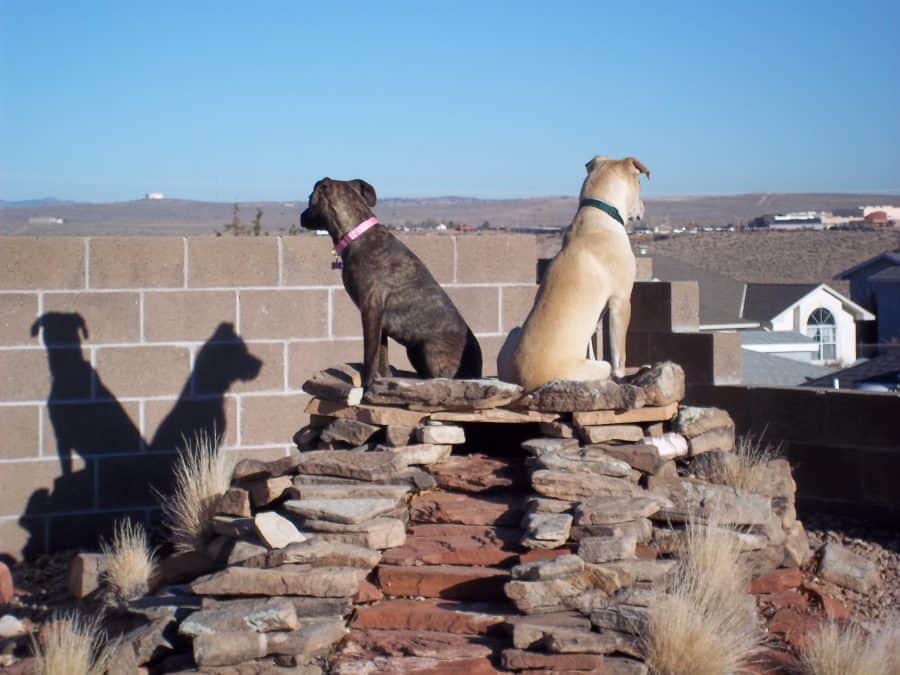
The story of Princess and Juneau,
from Shelter to Home
Each year, thousands of dogs are adopted out from local shelters and rescues. Many of them fit well into new homes, but there are some whose history and treatment give them little chance for a future. In some shelters they will sit there for years. At kill-shelters, not very long. As staff is limited, many volunteers help out and save many more dogs. But some remain and my focus and this article is to show what can yet be done for them.
Where They Came From
Several years ago little Princess came into a local shelter. She was apparently a backyard dog who had lived there with a few puppies but nothing more. Feral, underweight, and about a year old, she was afraid of all people and adult dogs. Move toward her and she runs; catch her and she pancakes on the ground and ignores any leash. Lift her and she’s limp and dropping poop.
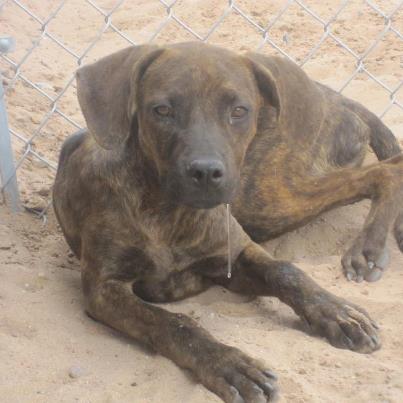
Juneau was a bouncing young Lab of about one and one-half years. Bouncing fine with puppies but scared of many adult dogs. Scared enough that most people who tried to get him out of his kennel were bitten.

Since this was a kill-shelter, neither dog had a chance. Juneau was already on that list, and Princess was sure to follow.
Canine Behavior Rehabilitation – Helping a Dog to Be a Dog
Princess was first pulled from the shelter into a rehabilitation program. Very different than any dog obedience training, rehab focuses on producing a happy and well balanced dog who has acquired social skills with both people and dogs. At first, Princess was nearly shut down, with a fairly high level of apathy where she tried to ignore all the fearful things in the world. With apathy, as with different types of anxiety, there are established protocols that will often help them.
The high-apathy dogs are perhaps the hardest of all issues to work with. They have given up on life and it may take weeks or months to even ignite a spark of interest. Picture a dog who huddles in the back corner of a kennel, frozen in position and staring into space as you approach. Flies come around and sit on her muzzle and she doesn’t even move.
But Princess was only a year old and there were small signs of interest, which was the real key. To begin it took three days of work, each session lasting only a minute or so, but repeated over fifty times each day.
Finally, she got up and walked over to me for a few minutes, accepting and taking comfort in some gentle petting. Her interest then became high enough that the apathy quickly faded.
From that point, we made good progress in starting to deal with her fears. She learned new behaviors that became comfortable and enjoyable, and they gave her the rules to provide her with security. A training dog slowly fanned her interest in play, but also began to teach her the play and social skills needed with adult dogs. She learned to accept corrections from another dog without panicking. How to signal and defer to another dog, and he quickly became her initial point of security. In a few days she went on leashed walks with him and more than another week passed before I could finally walk her alone.
From flee, to fight
During this time a scared Lab arrived, but his issues were far less serious and he was adopted in a few weeks. At that point, Juneau was on a volunteer hold at the shelter to keep him safe for a short time, and was pulled from the shelter a few days after that other Lab was adopted.
While Juneau had bitten people, he was not really human aggressive, and actually had fairly good tooth control and bite inhibition. However, whenever he was scared his head would thrash from side to side and he’d snap at the air or anything in front of him. When taking him out of his kennel it was a pretty sure bet that he’d be scared of at least some of the other dogs who were barking and lunging. People tried to correct his behavior with leash pulling and water squirting. All of which made it worse, and he bit several volunteers and a staff member.
On seeing his behavior and reactions, I brought him only partway out, loosely holding the leash about his head to keep one hand safe, I kept my legs behind his shoulders, and gently put my other hand on the middle of his back and spoke to him calmly and waited. After a few seconds, he stopped and just stood there. I walked him that way half-way out then stopped by some lunging dogs. Juneau twitched a few times, then relaxed and stood. To confirm this, I repeated this procedure five times that day, and each time he responded the same. He was just scared and needed reassurance.
That behavior will likely continue for quite some time, but the focus in rehab was on making it less often and less intense and ensuring that a person can safely control him. Note that this is not simply bad behavior that you can correct and replace with another. Instead, it is a fear that he has to learn to overcome. Part of that fear, similar to Princess, was in socialization with adult dogs.
The rehabilitation protocols
Some of the key work needed during rehab is described very well in Dr. Karen Overall’s protocols for Deference and Relaxation. As a renowned veterinary behaviorist, she explains well the differences between these protocols and obedience training, both in their content and methods. Some other work done in rehab focused on the typical human behaviors and activities in a household. Things that young dogs typically pick up over a period of months were instead covered in weeks through more frequent exposure.
Each dog here will wait at least two minutes for a treat in front of him, even if my hand is moving all around and behind him. All meals and treats are with other dogs alongside. each one taking a treat by name, or waiting while another dog takes a treat right in front of him. All toys are shared. Deference and relaxation are the focus. Teaching extended stay, come, and other items can wait for obedience training. The items covered here allow them to live with people and other dogs.
If a 600-pound gorilla brought his hand over my head I’d duck quickly. Yet, this is what we want our dogs to get used to. So, in small stages, they did. Both dogs had to be fully handled and lifted without fear. I needed to yell or clap hands or other noises with only a natural startle and quick recovery. They needed to meet other dogs at a dog park, walk well on a leash, walking in stores and parking lots. All that and more had to be covered. Meeting people and behaving with small children, and standing in a pet food store while other people and their dogs walk by. I usually had two dogs at a time in stores, while some walks in the neighborhood had up to four dogs.
Perfect leash control was not the goal, and that’s difficult to do with several dogs. But each dog learned to stop or continue on command so there was no constant pulling or issues. Both outside on walks and in stores.
The expert assistant
While there are many dog trainers around, there are few people who do behavior rehabilitation, and many dogs who will not make it out of a shelter without some help. To do this you need both the most efficient scientific methods, and support from an expert assistant. For that it took me several months of working at shelters and searching before I found the right guy. He had been in the shelter for nearly two years, explained by his wild behavior with people and aggression towards some dogs. Yet he could also be very calm and relaxed at times. The shelter described him as:
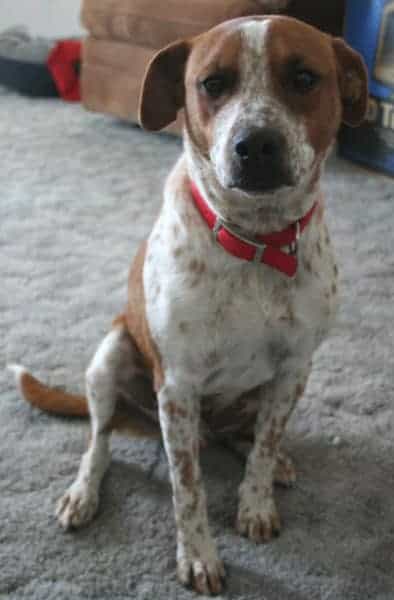
“Bandi was named after a torn and tattered red bandanna that was on his neck when he was found by Animal Control in an abandoned car, left to die. He was so scared when he first came to Watermelon Mountain Ranch. He obviously has not had much attention in his past because he craves it terribly and just loves to be with people. He should be the only animal in a home. Just didn’t get the proper upbringin’ but he still turned out precious with people. Just needs some TLC and would benefit from training and consistent attention. He’s been with us way too long. This boy is so deserving of the love he craves so much. Talk to us about Bandi!”
–Watermelon Mountain Ranch
Four months of specialized training later and he was ready to start gaining experience. This was not the typical obedience training though many basics were covered, but focussed on how to help and teach other dogs. Several months later a friend met him and asked if he knew how to lay down. Turns out I had never covered that, but easily taught him that night, because he had already learned how to learn.
He had learned to work with dogs who were scared, aggressive, or resource guarders. Bandi loved catching a ball, but learned to always give it to another dog who was insistent. With one aggressive resource guarder, he even took his training a step further. When Bandi got the ball and the other dog charged at him, he just whipped his head around and threw the ball at the other dog, who simply stopped in confusion. Apparently, my assistant was now teaching me things, and two days later he had that other dog sharing toys and food. While the shelter thought he should be an only animal, he shares his home with a cat and often a new dog every few weeks.
A former student comes to help

Over the months, Bandi has played a role in helping every dog who has come here. After teaching Princess how to play with adults, we brought one of Bandi’s former students in for some variety. After a short time, Junebug and Princess were like close sisters.
While on a trip to Lowes someone saw and fell for Juneau. While some dogs can go from rehab to most homes, Juneau was questionable as an only dog since he was a young lab just learning the world. We gave it a try but in less than two weeks it was clear this teenager just had too much energy to burn off. He came back for a few weeks, but the people missed him and wanted to try again, so this time he went out together with Princess. While a young lab is full of energy, Princess is a Mountain Cur, which is a Frontier dog that’s a mix of hound and terrier, whose underweight 28 pounds had come up to a firm 38 pounds, with enough energy to match this 65-pound lab. Very soon the combination proved effective, with the lady keeping him in line.
Both of them will need more work, as Princess is slowly getting used to her new people and bonding with them. Juneau the teenager is testing the rules, and a dog trainer was brought in to show the people how to manage this.
Addendum
It is now over two years later. Every few months I went to visit Princess and Juneau in their home, and they still recognize the sound of my truck as I pull up. Juneau is now heavier as an adult Lab, but Princess surprised us by nearly doubling her weight, and it now appears the little Cur was mixed with a Mastiff.
